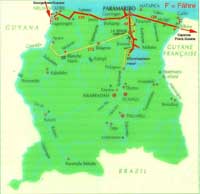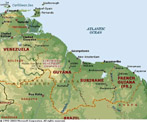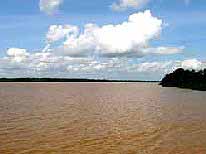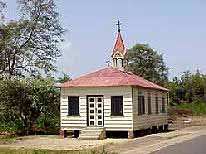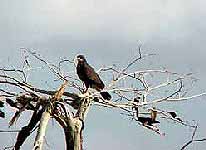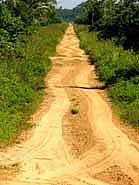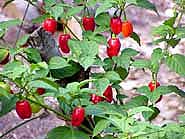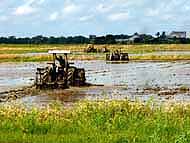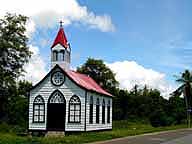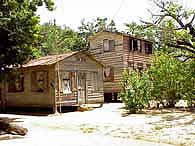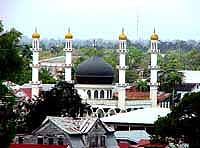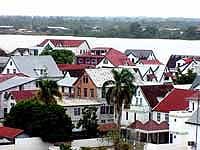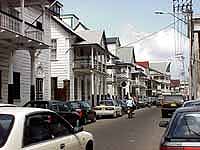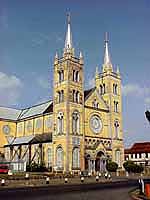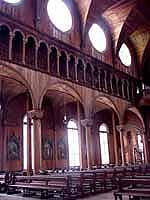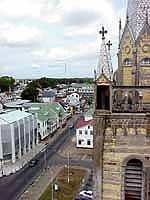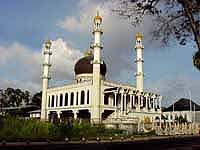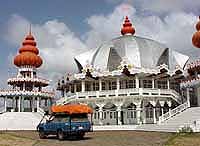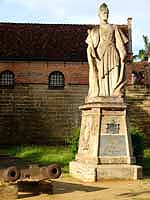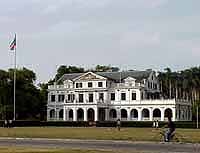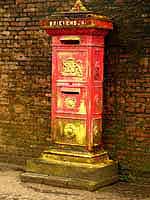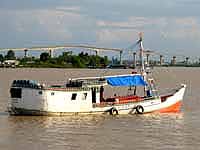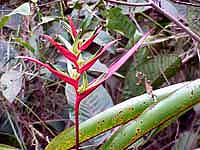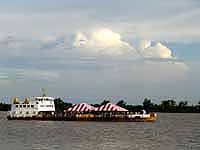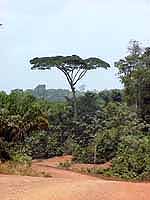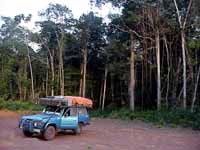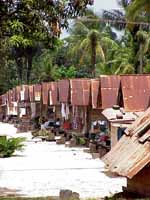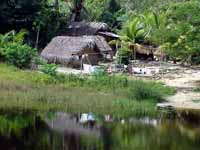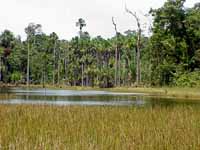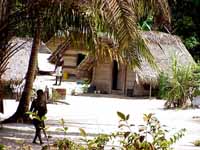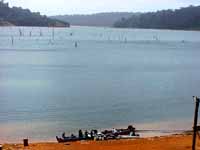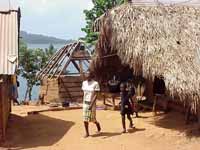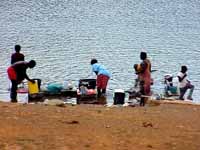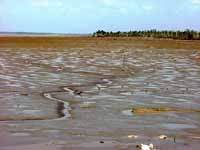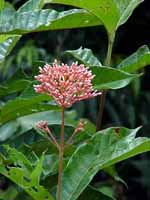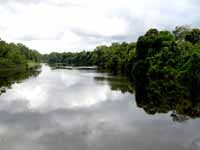Enjoy some pictures of the worldrecordtour, taken in Suriname
|
|
click a picture to see details |
|
|
|
||
|
|
|
|
|
|||
|
|
|
|
|
|||
|
|
|
|
| Of course, the delight of discovery
is less intensive on a second visit. Everything looks familiar, everything is more
routine. Nevertheless, we enjoy being in Suriname again. People are friendly, open and
interested. And it is also nice to be able to sit relaxed at the riverfront even in the
evening hours and sip a cold, big Parbo beer, what was unimaginable in Guyana. But at
night, we still prefer to be behind fences on a guarded area. This time, we are allowed to
park in a compound of a sport club. We may use the showers, toilets and restaurant, but
not the tennis court ( we anyway do not play tennis) and the large swimming pool until the
last evening, when the vice-president personally allows us nevertheless to jump into the
pool - but unfortunately only the last evening.
|
|||
|
|
|
|
| This time, we reduce our activities to the capital Paramaribo, which with its 300’000 people shows more a city character compared with Georgetown with about the same population. Again, we admire the classical Dutch colonial buildings with their white colonnades, and the golden-white mosque being said to be one of the biggest in the Caribbean, situated just besides a white Synagogue with rather simple architecture – no doubt exclusively in the world. Then there are many decorative Indian temples, particularly the Arya Dewaker, and the yellowish Roman Catholic wooden cathedral which claims - as does simultaneously the cathedral in Georgetown – the title of the world’s biggest freestanding wooden structure. Two years ago, we were able to climb nearly vertically to the tower platform via a rotten wooden stairway, from where we could enjoy a fantastic view over Paramaribo’s streets and houses, the Suriname River and its huge bridge, the mosque and the palm grove called “Palmentuin”. Now, the church is closed for renovation.
|
|||
|
|
|
|
| Our preferred spot is the “Waterkant”, the well maintained little promenade with restaurants at the riverfront, where also the locals enjoy their free time. Frequently they carry also little cages with a small finch along which - like in the neighboring countries – is getting trained for singing competitions. On Sundays, it gets really busy when the old ferry, changed into a party boat, packed with a bunch of happy people sails the river up and down - singing and dancing to the sounds of local rhythms. While in Guyana the Caribbean impact with Calypso, Soca and the aggressive rap style from Jamaica prevails, here in Suriname more modern African music with partly Caribbean and Indian influence is heard. Interesting is also the mixture of races: 35% Indians, 10% Negroes (bush Negroes), 31% Creoles, 15% Indonesians, 7% Chinese and Europeans. Or from the religion’s side: 48% Christians, 27% Hindus, 20% Muslims and 5% mixed, including Jews and other beliefs.
|
|||
|
|
|
|
|
|||
|
|
|
|
| Unfortunately, there are actually no sand beaches in Suriname, only brownish muddy water which the Amazon River releases into the Atlantic Ocean and which makes its way all along the so called Guyana coast up to the Orinoco River delta, supported by numerous big and sluggish river estuaries. Therefore, Suriname is not really a tourist destination, though it offers other kind of attractions: 95% of the total 63’040 square miles are covered with pristine rain forest, but most of it can be discovered by private plane, boat and by foot only. The majority of the total population of 438’000 people lives in the completely flat Northern coastal strip on the remaining 5% of land. But the Brownsberg Nature Reserve is still accessible by car. We did the trip two years ago. The fascinating point is that as soon as you leave the classical colonial buildings of the capital, you dive into deep traditional looking Africa: Bush Negroes live in thatched houses in a little forest clearance along a sandy red track, topless women disappear as soon as we stop and occasionally a monkey crosses the road. If we thought to be able to do the 125 miles return trip easily in one day, we were completely wrong. We could not drive faster than 13 miles/h through the badly potholed, bumpy and sandy track. When we finally hit a larger and better maintained road, the traffic became stronger and we were constantly driving in a cloud of red dust. Having no air-conditioning and temperatures in the 100’s meant pulling up and down the windows continuously.
|
|||
|
|
|
|
| The mountain road to the Nature Reserve forks in the small settlement of Brownsberg, which consists of a couple of wooden thatched huts. It is a windy, one-lane, steep road up hill. As we drive through the dense jungle we remember the recommendation of the Tourist Office that we should rent a car in the village to guide us – costs US$30. This is just to make money! Unfortunately we can hardly see the “Blommestein Meer” due to the hazy pre-rainy season conditions; we only get an idea of its size. Mid-afternoon, we decide to make a break for lunch in an unused gravel pit surrounded by jungle. Suddenly we notice that one of the tires is getting flat, what means for Emil that he gets work to do. Until he is finished, it is definitively too late to move on, so we decide to pitch up our camp right here. With nightfall, there is no sign at all of the usual awakening of the jungle. Besides some fireflies blinking in the darkness and some screams of birds no special events happen. Disappointed we go to sleep.
|
|||
|
|
|
|
| In the early morning hours, we continue to the picturesque hut village of Afobaka situated at the Bloomestein dam, which produces the countries electricity needs. Women are washing clothes, men are fishing and a colorful boat is packed for a picnic. Mid-afternoon, we return on the same dusty roads back to Paramaribo. At a sandy passage, a yellow bus with two black guys is stuck. We pull them out with our winch. Their happy faces and clapping hands is “thank you” enough. In the evening we are busy for three hours to clean our LandCruiser in and outside from the sticky red dust. Nevertheless: The hinterland was worth the visit!
|
|||
|
|
|
|
| The first word we learnt in Dutch was “Drempel” - what means speed breaker or bump. They are very frequent and a complete nuisance. Apart from Mexico, where they are called “Topes”, we have not seen them in such hindering numbers. By the way, we find it rather strange to be approached in the Dutch language in tropic surroundings. But because we are white, we must be from Holland! While Dutch is the official language, a majority speaks also a mixed language “Sranang Tongo” (also called Taki-Taki), of which we do not understand one word. Besides, most people learn English, and of course also Hindi, Javanese and Chinese are often heard. Recently there was even a discussion about the introduction of English as the country’s official language. Besides it is very interesting that Swiss citizens – apart from some other “exotic” countries – don’t need a visa to visit Suriname, but obviously the Dutch and its French neighbors do.
|
|||
|
|
|
|
| As it was already the case two years ago, also today our unique LandCruiser is constantly surrounded by admiring and curious people, which opens us the door to many invitations. We meet Erika and Sigi from Switzerland, who migrated six years ago to Suriname, being able to live here in the tropics comfortably with Erika’s Swiss pension. Sigi is a brilliant black musician from Suriname who – as a “one man band” – plays at weddings, church meetings etc. One day, Erika cooked a delicious meal for us, and as a special treat, served us famous Swiss cookies called “Basler Läckerli” together with coffee. Then we encountered Köbi, also from our home country, working as engineer for an international Swiss company. Here, he was supervising a grain unloader for ships. We shared some big one liter bottles of Parbo beer at the riverfront restaurants. Then there was Philippe, the French policeman, who came to Suriname for a weekend and spontaneously offered us his apartment in Saint Laurant-du-Maroni across the border river in French Guiana, where we really visited him later. But we made also many interesting contacts with the local population. It is pouring down heavily, as on May 31st, 2005, we say good-bye to the hospitable Suriname for the second time and the French ferry takes us from the small border town of Albina across the more than a mile wide brownish Marowijne river to an even more tropical land.
|
|||
|
|
|
|
|
|||
